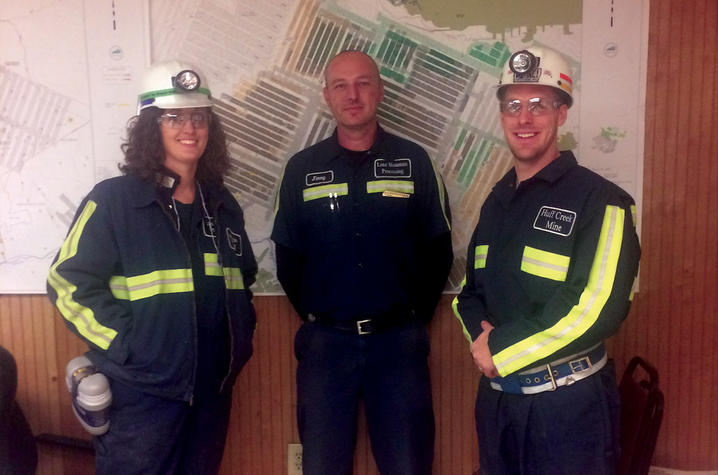Experiential Learning to the Extreme: PT Students Use Coal Mines to Understand Challenges Faced by Miners

HAZARD, Ky. (July 18, 2017) — David Nelson stumbled through a coal mine, trying to navigate safely through what felt like, in his words, "a "giant, dark, low-roofed super store with coal the size of softballs and nothing but our balance and the light source from our helmets to rely on."
Nelson is not a miner. He is a DPT (doctor of physical therapy) student at the UK College of Health Sciences' Hazard campus, and the "field trip" provided an out-of-clinic opportunity to understand the physical challenges and potential injuries miners face in the course of their work.
Nelson’s trip into the coal mine was made possible by Tim Yost, co-director of PT Pros in Harlan and a UK College of Health Sciences alumnus. Yost considers it paramount that DPT students get hands-on experience as part of their clinical education, including some outside the typical clinic setting. Nelson, along with PT Pros employee and physical therapist Melodye Ramsey (also an alumna), went underground last fall.
The pair received safety training, coveralls, hard hats, steel-toed boots, mining lights, and self-rescue devices (portable oxygen). Along with their guide, they were transported on a “man-trip," or underground personnel carrier, about a mile into the mine.
Ramsey, whose husband is a mining engineer, had long wanted to go into the mines to experience his working environment.
“I had envisioned it to be like a narrow cave, but the entries were very wide and were connected by cross-cuts every several feet, which made it seem like a little underground city," Ramsey said. "It’s amazing how complex the inner workings are: ventilation, directional signage, escape routes, and entrance and exit routes. I was surprised at the amount of electricity they had in the mine to run and operate their equipment.”
The stereotypical image of the coal miner with rudimentary tools has been replaced by efficient heavy machinery, Ramsey said. But even as mining techniques have become more sophisticated, the work environment still presents unique challenges and risks for mining engineers.
“Our patient/miners are involved with very heavy machinery in ceiling heights ranging from 20 inches to 17 feet,” Yost said. "This puts the worker in challenging positions at times, which makes it difficult to perform correct body mechanics. Providing them with flexibility, strengthening, and functional ideas can be an important tool in improving their safety, posture, and symptoms.”
Yost explains further that when a worker is injured, it's critical to understand the work environment that contributes to a patient’s physical condition, particularly if the patient will return to work in that environment.
Jeff Branson understands both the everyday demands of the coal mining environment and the lasting effects of an injury. He was an underground coal miner for 12 years before he was seriously injured in a large rock fall several years ago.
“The rock fall did significant damage to my pelvis, hips, knees, right shoulder, and left femur,” Branson said. “The damage was extensive, and I wasn’t sure if I would walk well again, let alone work."
Yost has treated Branson's two hip replacements, pelvis fracture, right shoulder injury, back pain, left femur ORIF [open reduction and internal fixation], and knee pain resulting from his accident. Although Branson couldn’t return to underground coal mining, Yost helped prepare him to handle the challenges of returning to school and becoming a teacher and a coach at Harlan County High School.
"I now work out regularly and am able enjoy time with my family on a more physical level than I could have been otherwise," Branson said.
Nelson says he has already been able to apply what he learned in the coal mines to patient care.
“The week after my visit to the mines, I was able to adjust aspects of my treatment with a patient who had sustained an ankle fracture and challenge him with simulated mining tasks and environment,” Nelson said. “The experience opened new thinking on ways to challenge my patients based on functional tasks specific to their environments.”
Yost, a native of coal country and the son of coal miner, sees that knowledge of a working environment informs the physical therapy practice for students, new grads, or seasoned PTs, with an eye toward the best possible outcome for patients.
"It is vital for physical therapists to visit industrial facilities in their community, whether it's a coal mine, an automobile plant, a furniture factory, or a package processing facility," he said. "This provides the resources for an informed conversation with the patient, rehab nurse, and physician and the opportunity to tailor a rehabilitation program for that patient that helps them return to work safely.”




